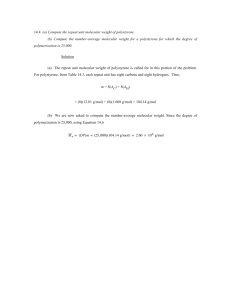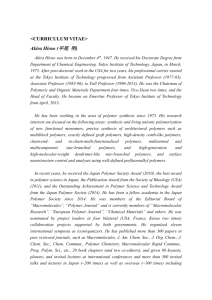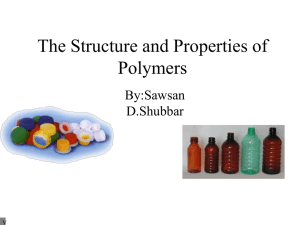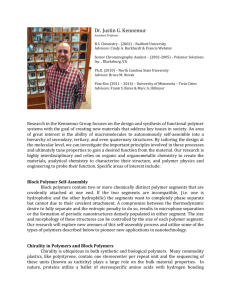Suggested Problems for Ch 15 w/key for selected problems 2,3,8,10
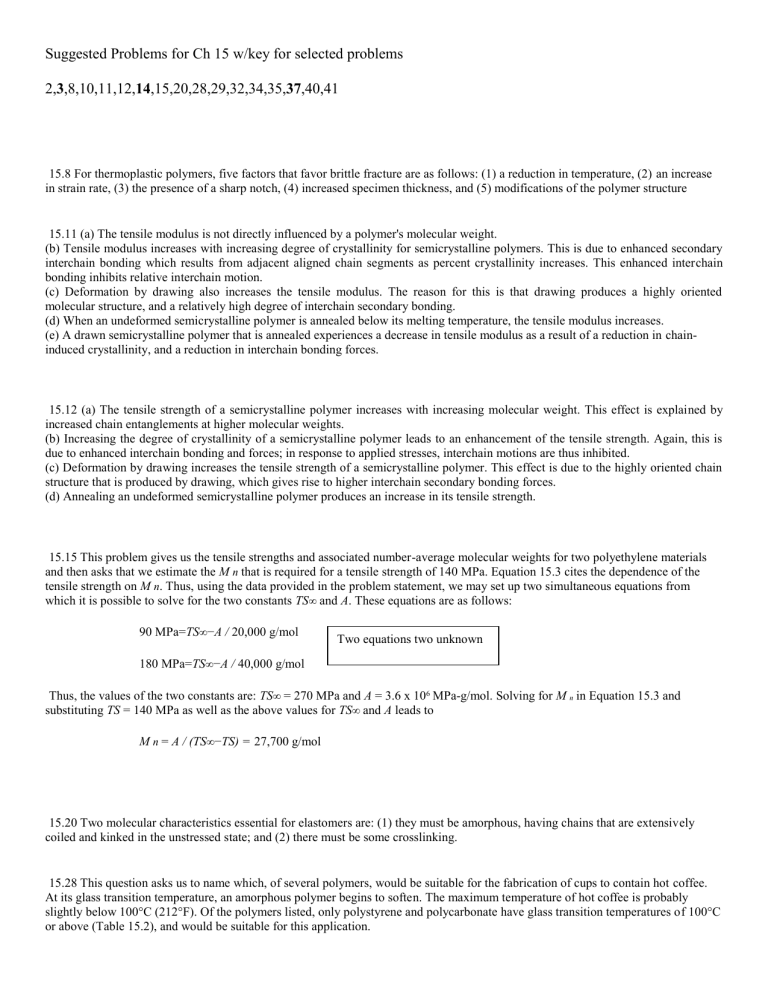
Suggested Problems for Ch 15 w/key for selected problems
2, 3 ,8,10,11,12, 14 ,15,20,28,29,32,34,35, 37 ,40,41
15.8 For thermoplastic polymers, five factors that favor brittle fracture are as follows: (1) a reduction in temperature, (2) an increase in strain rate, (3) the presence of a sharp notch, (4) increased specimen thickness, and (5) modifications of the polymer structure
15.11 (a) The tensile modulus is not directly influenced by a polymer's molecular weight.
(b) Tensile modulus increases with increasing degree of crystallinity for semicrystalline polymers. This is due to enhanced secondary interchain bonding which results from adjacent aligned chain segments as percent crystallinity increases. This enhanced interchain bonding inhibits relative interchain motion.
(c) Deformation by drawing also increases the tensile modulus. The reason for this is that drawing produces a highly oriented molecular structure, and a relatively high degree of interchain secondary bonding.
(d) When an undeformed semicrystalline polymer is annealed below its melting temperature, the tensile modulus increases.
(e) A drawn semicrystalline polymer that is annealed experiences a decrease in tensile modulus as a result of a reduction in chaininduced crystallinity, and a reduction in interchain bonding forces.
15.12 (a) The tensile strength of a semicrystalline polymer increases with increasing molecular weight. This effect is explained by increased chain entanglements at higher molecular weights.
(b) Increasing the degree of crystallinity of a semicrystalline polymer leads to an enhancement of the tensile strength. Again, this is due to enhanced interchain bonding and forces; in response to applied stresses, interchain motions are thus inhibited.
(c) Deformation by drawing increases the tensile strength of a semicrystalline polymer. This effect is due to the highly oriented chain structure that is produced by drawing, which gives rise to higher interchain secondary bonding forces.
(d) Annealing an undeformed semicrystalline polymer produces an increase in its tensile strength.
15.15 This problem gives us the tensile strengths and associated number-average molecular weights for two polyethylene materials and then asks that we estimate the M n that is required for a tensile strength of 140 MPa. Equation 15.3 cites the dependence of the tensile strength on M n . Thus, using the data provided in the problem statement, we may set up two simultaneous equations from which it is possible to solve for the two constants TS ∞ and A . These equations are as follows:
90 MPa= TS ∞ − A / 20,000 g/mol
180 MPa= TS ∞ − A / 40,000 g/mol
Two equations two unknown
Thus, the values of the two constants are: TS ∞ = 270 MPa and A = 3.6 x 10 6 MPa-g/mol. Solving for M n in Equation 15.3 and substituting TS = 140 MPa as well as the above values for TS ∞ and A leads to
M n = A / (TS ∞ − TS) = 27,700 g/mol
15.20 Two molecular characteristics essential for elastomers are: (1) they must be amorphous, having chains that are extensively coiled and kinked in the unstressed state; and (2) there must be some crosslinking.
15.28 This question asks us to name which, of several polymers, would be suitable for the fabrication of cups to contain hot coffee.
At its glass transition temperature, an amorphous polymer begins to soften. The maximum temperature of hot coffee is probably slightly below 100°C (212°F). Of the polymers listed, only polystyrene and polycarbonate have glass transition temperatures of 100°C or above (Table 15.2), and would be suitable for this application.
15.29 In order for a polymer to be suited for use as an ice cube tray it must have a glass-transition temperature below 0°C. Of those polymers listed in Table 15.2 only low-density and high-density polyethylene, PTFE, and polypropylene satisfy this criterion.
15.32 For an amorphous polymer, the elastic modulus may be enhanced by increasing the number of crosslinks (while maintaining the molecular weight constant); this will also enhance the glass transition temperature. Thus, the modulus-glass transition temperature behavior would appear as
15.34 Two important characteristics for polymers that are to be used in fiber applications are: (1) they must have high molecular weights, and (2) they must have chain configurations/structures that will allow for a high degrees of crystallinity.
15.35 Five important characteristics for polymers that are to be used in thin-film applications are: (1) low density; (2) high flexibility;
(3) high tensile and tear strengths; (4) resistance to moisture/chemical attack; and (5) low gas permeability.
15.40 Four factors that determine what fabrication technique is used to form polymeric materials are: (1) whether the polymer is thermoplastic or thermosetting; (2) if thermoplastic, the softening temperature; (3) atmospheric stability; and (4) the geometry and size of the finished product.
15.41 This question requests that we compare polymer molding techniques. For compression molding, both heat and pressure are applied after the polymer and necessary additives are situated between the mold members. For transfer molding, the solid materials
(normally thermosetting in nature) are first melted in the transfer chamber prior to being forced into the die. And, for injection molding (normally used for thermoplastic materials), the raw materials are impelled by a ram through a heating chamber, and finally into the die cavity.



